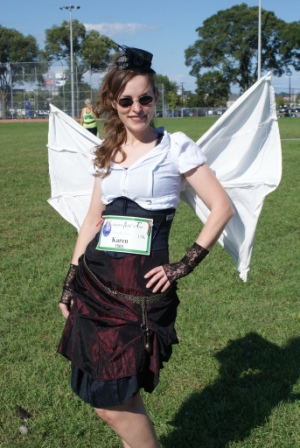Ouch, thunk, ouch, thunk – how it sounds to run with arthritis in your knees
The following is a post guest post from Carolyn Pleasance, originally posted to her blog.
________________________________________________________
Owie….or running just to hear myself whine.
They say love hurts…I’m not sure why running has to, since sometimes I don’t think I love it…however I’m developing a relationship with my physioterrorist that rivals that which I have with my husband. She’s spent hours rubbing oils and potions and lotions on my body, she’s asked me to lie down, roll over, stick this body part here and that one there.
All this in the quest to fix the arthritis in both my knees. Every time she pulls the Graston rods out I try to slither backwards off the table. I’ve never known a strange creepy pain like that one. If you’ve never been Grastoned before, picture this: first they apply lotion to whatever part of you is going to be tortured. Then they take this metal rod, sort of like a banana clip hair thing in shape, but solid metal, and they pull it along your skin like they’re trying to roll the area flat, or squeeze the last of the toothpaste out of the tube. This causes every bit of skin, muscle, tendon, whatever else lurks there to be compressed and pulled at the same time. Yep, it hurts, nope you don’t get used to it, and yep (again) it’s worth it. Then to add insult to injury, you get these electrodes attached to the owie bits and they run this freaky currently through it that feels like a zillion electric bugs crawling under your skin. And I pay for the honour of having this done to me too.
So the knees are happier than they’ve ever been. I don’t look at the stairs in my house and consider just living in the kitchen and showering in the sink.
The bummer is that my new shoes (which apparently have tons of motion control and stability) have caused me to become newly unstable and do damage to a tendon in my left foot. Just when god slams the door he also locks the window. Back to physio where I now have my left foot bashed against a wooden block (I don’t understand it either) and to the Running Room to buy me some new kicks. Three pairs and a half hour on the treadmill testing them later, and I’m back on the road. The knees only protest meekly and the foot wonders why I have forsaken it, but I’m on a mission to increase my speed and therefore can mostly ignore the twinges.
The secret to increasing your speed is to run faster. I know, who’da thunk? The secret to running faster is to run shorter distances faster than you normally run longer ones. The secret to doing this is not to smash into something or run off the trail while staring at your Garmin to see how fast you’re going.
ouch, thunk, ouch, thunk…..



 Current Issue
Current Issue Previous Issue
Previous Issue Prior Release
Prior Release
